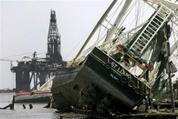
SABINE PASS, Texas - As Texans watched Hurricane Rita — at one point a terrifying Category 5 storm — spinning in the Gulf, they didn't see a best-case scenario. The storm was on track to slam Galveston and drench flood-prone Houston.
f it moved north, the Golden Triangle of the petroleum industry would get a direct hit.
But the storm weakened slightly and made landfall in a tiny, evacuated shrimping village surrounded by marsh and a wildlife refuge, perhaps the best place to avoid deaths and economic damage.
And it changed course. On Wednesday and early Thursday, Rita appeared headed straight for the city of Galveston and the heavily populated corridor between there and Houston.
Visions of a repeat of Katrina spurred a mass evacuation, which ended up causing more deaths than the storm itself — 23 people were killed when a bus of nursing home evacuees burst into flames in gridlocked traffic Friday.
As of Sunday, only two deaths were blamed directly on the storm, that of a Mississippi woman who was killed by a tornado that spun off the remains of the hurricane and a Texas man who suffered a broken neck and head injuries after a tree fell on him.
Rita's eye came ashore over Sabine Pass early Saturday, doing the kind of wholesale damage to the town that was seen up and down the Mississippi coast during Hurricane Katrina.
The most intense side of the storm passed over lightly populated areas of southwestern Louisiana before causing significant damage in Cameron, Lake Charles and Abbeville.
In Port Arthur, 10 miles north of Sabine Pass and the first significant city the storm hit as it came ashore, water never topped the 17-foot seawall that shields the city from Sabine Lake.
"From my point of view, we're lucky," Port Arthur police officer Mike Hebert said Sunday, as he watched crews remove a boat that had washed up on the road. "It could have been a lot worse."
Though floodwaters came into the city after Rita, the stormwater pumps did their job, and most of the water was gone by Sunday.
Farther north in Beaumont, though, Jefferson County officials said it will be days, if not weeks, before the electricity, water and sewer service can be restored.
Police officers were stationed at exits from Interstate 10, turning back residents trying to return home. |  |
County Judge Carl Griffith said "we have a horrible disaster" but noted that a last-second airlift and bus evacuation of the sick and others with special needs removed some 10,000 people from the county.
"Had they not done that, people today would be dead," Griffith said.
At the port in Sabine Pass, shrimp boats were pushed up onto docks and piled atop one another in a jumble of masts, ropes and nets.
Longtime residents know their town is vulnerable to hurricanes. It was wiped out in 1886 by a storm that killed 86 people, and hit again in 1900 and 1915.
Hebert, the police officer from nearby Port Arthur, said many would rebuild. "These people are tough," he said.
The destruction, though, was devastating for some.
Don Jones, 48, was among the first of the 370 residents to return home Sunday to Sabine Pass and found he had lost his home and nearly everything he'd accumulated in a lifetime.
"All I got right now is my fishing pole and this cooler full of shrimp," he said, towing the plastic foam container through the knee-deep waters that covered the streets.
"We did not dodge the bullet," he said, estimating that 80 percent of his hometown was destroyed. "We got smashed."
No comments:
Post a Comment